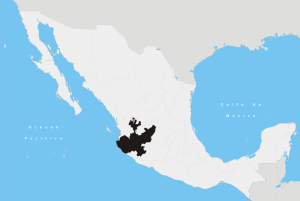San Juan de los Lagos
San Juan de los Lagos (Spanish for "Saint John of the Lakes") is a city and municipality located in the northeast corner of the state of Jalisco, Mexico, in a region known as Los Altos. It is best known as the home of a small image of the Virgin Mary called Our Lady of San Juan de los Lagos or in Nahuatl Cihuapilli, which means “Great Lady.” Since the first major miracle ascribed to her in 1632, she has been venerated especially for cases involving mortal danger. The miracles ascribed to her have made the basilica in which she is found a major tourist attraction, which has shaped the city's history to this day. The economy of the city is still heavily dependent on the flow of pilgrims which has amounted to between seven and nine million people per year.
San Juan de los Lagos | |
|---|---|
Municipality and City | |
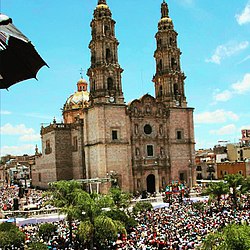 Basilica of San Juan de los Lagos | |
 Flag  Seal | |
| Nickname(s): San Juan | |
| Motto(s): Bienvenidos Peregrinos de Paz | |
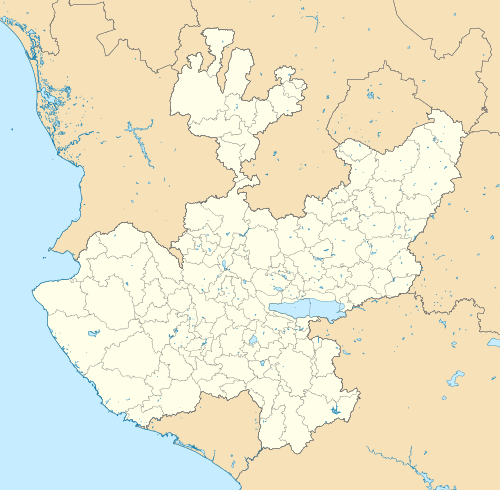 San Juan de los Lagos Location in Mexico, Guadalajara, Jalisco  San Juan de los Lagos San Juan de los Lagos (Mexico) | |
| Coordinates: 21°14′45″N 102°19′51″W | |
| Country | |
| State | Jalisco |
| Government | |
| • Municipal president | Alejandro C. DeAnda Lozano National Action Party (Mexico) |
| Area | |
| • Total | 874.47 km2 (337.63 sq mi) |
| Population (2010) | |
| • Total | 65,684 |
| • Density | 63/km2 (160/sq mi) |
| Time zone | UTC−6 (Central Standard Time) |
| • Summer (DST) | UTC−5 (Central Daylight Time) |
| Website | www |
The City
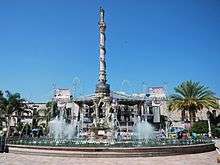
Many of the buildings in the center of the city are made of pink sandstone dating as far back as the 17th century, with the streets fanning out from the main square.[1][2] There are twenty two historically notable buildings in the city.[3] These include four parish churches in the municipality, Sangre de Cristo, San Jose, San Juan Bautista and Sagrada Familia and two chapels Primer Milagro and El Calvario.[1]
The Plaza de Armas or Rita Pérez de Moreno Civic Plaza is in the center of the city. It was designed by Roque Picaso in the 18th century, and later modified by Salvador Gómez. In the center, there is a Monument to Independence, erected in 1872. It consists of a thin column supported by a base which has four dragon figures. At the top, there is marble sculpture of a woman holding a laurel crown. The monument stand in the center of a large circular fountain.[4]
The Cathedral/Basilica of the Virgin of San Juan de los Lagos faces the main square of the city, and dates to 1732.[3] It has a facade of pink sandstone with two narrow Baroque towers and a portal with three levels and a crest. In this portal, there are Tuscan columns and cornices along with geometric and anthropomorphic reliefs. The interior has stained glass windows and a cupola with painted scenes. The walls and ceiling of the nave are richly decorated with gold leaf and cypress woodwork, especially in the capitols, pilasters and other niches. The main altar is made of sandstone and cypress in Neoclassical style. In the center is the image of the Virgin of San Juan de los Lagos. The sacristy contains oil paintings and furniture with incrustations. The chamber behind the main altar contains six works by Rubens.[4]
On the side opposite from the Basilica is the municipal palace. It was constructed at the end of the 18th century of stone covered in sandstone tiles. It originally was a house, then a seminary, before its current function which began in 1938. During the War of Independence, it temporarily housed viceroy Felix Maria Calleja while he and his troops were pursuing Miguel Hidalgo.[4]
The Chapel of the First Miracle was first built as a hermitage in the 1530s.[3] The current structure dates from the 17th century. Its facade is simple, made of sandstone with a single tower that has Corinthian columns and vegetative reliefs. The portal is simple with a rounded arch. The choral window has a sandstone frame and niches above it with sculptures. The interior is a single nave with a main altar in Baroque style in white sandstone, with Solomonic columns that support a semicircular pediment. The rest of the decoration is simple with some sculptures of saints on the walls. To the side of this chapel is a former hospital, which also has a simple facade and portal.[4]
The Capilla del Pocito is where, according to legend, a small girl brought forth a fresh water spring in 1663 by striking the area with a stone. The spring still flows.[3]
The Temple of Calvary dates from the 17th century, constructed in pink sandstone. It has the appearance of a Greek temple with stairways, arches and columns. The facade features large sculptures of the Twelve Apostles.[4]
The Parish of San Juan Bautista was constructed in 1648. The Temple of the Holy Family was constructed in 1841 in Neoclassical style. The Parish of Sangre de Cristo was constructed at the beginning of the 19th century.[4]
The Rita Pérez School was built in the 1770s in Neocolonial style. It began as a gambling house, then an inn and barracks. In 1949, it was converted into a school by the municipality.[4]
The Old Episcopal House was rebuilt in the 19th century and currently houses the post and telegraph offices.[4]
The Casa de Correos became the Casa de Cultura. It is located on one side of the main plaza.[3]
The festival dedicated to the Virgin of Candlemas, celebrated from 25 January to 2 February is the most important for the municipality. It is celebrated with processions, live music, various traditional dances such as Moors and Christians by the many visitors from all over Mexico. There are also fireworks and amusement rides.[4]
The Fiestas de la Primavera (Spring Festivals) are held for five days at the end of May with bullfights, live music, dances and cockfights. This concurs with events dedicated to the Virgin Mary which are held through the entire month. During Holy Week, it is customary to visit all seven churches of the main city.[4]
In 2010, the Secretary of Tourism for the state began a Festival of Mariachi, Charrería and Tequila in the city to coincide with the Independence Day holiday in San Juan. It is part of an effort to revive certain area traditions. In addition to traditional dance and music, local tequila and mezcal producers offer samples of their products. There is also a parade with floats and mojigangas and a beauty contests featuring representatives from the various communities of Los Altos.[5]
During festivals and other times, various local foods are available. Typical dishes include pozole, tamales, milk candies and cajeta (dulce de leche) and fruits such as cactus fruit, oranges and figs preserved in sugar. Traditional drinks include ponche made from local fruits.[4] Another traditional confection is a large disk of a coconut confection called “alfajor.”[2]
Pilgrimage site of Our Lady of San Juan de los Lagos

The pilgrims come to the city to pay homage to a small image of the Virgin Mary called Our Lady of San Juan de los Lagos, but sometimes referred to by her Nahuatl name of Cihuapilli, which means "Great Lady."[6] This image is very small, about 38 cm tall, made of sugar cane paste and believed to have been brought to the area from Michoacán in the early 1500s. The first important miracle ascribed to the image dates to 1623. A family of acrobats had a show which included “flying” over a field of spear points. The seven-year-old daughter fell onto the spears during the act and immediately died. Local women brought the image to the body and prayed over it when the child revived. This miracle made the image famous.[6] Since then, many other miracles have since been attributed to her intercession, often related to recuperation from mortal danger or dangerous illnesses.[7]
The original hermitage that stored the image was built in 1543, with the first chapel dedicated specifically to the image build in the 1638.[4][6] The current basilica/cathedral was begun in 1732 and was finished except for the bell towers in 1779. This church was made possible by a steady flow of offerings to the image that continued from colonial times until the Mexican Revolution. This war reduced the flow of pilgrims and gifts but both returned after and have kept the city and image a major religious attraction for the country. In 1904 the Pope granted permission for the crowning of the image. The church was elevated to a minor basilica in 1947, and to a cathedral in 1972. Pope John Paul II came to San Juan de los Lagos to visit the image in 1990. The statue of the virgin was restored by sculptors in 2005.[6]
San Juan de los Lagos is the second most visited pilgrimage site in Mexico, after the Basilica of Our Lady of Guadalupe in Mexico City.[1][8] It is an important tourist attraction for the state of Jalisco.[2] Hundreds visit the basilica every day, with estimates of yearly visits usually numbering around seven million, but estimated at nine million for 2009.[9][8][2] On religious holidays, the church and its immediate surroundings are packed. The most important days for this image are February 2, most of May, August 15 and December 8, those times associated with Mary.[6] Two million come during Candlemas alone.[3] At peak visitation times, the crowd spill out from the basilica and crowd onto the streets of the city.[9] Church authorities indicate that there is a severe need to improve facilities for the pilgrims and provide more space.[9] During peak periods, demand for hotel space far exceeds supply and the municipally opens shelters with basic services.[1] The shelter has been constructed to accommodate 20,000 pilgrims but it is insufficient at peak times.[3]
Organized groups may walk or bike for hundreds of miles, but most arrive by car or bus. Many pilgrims will cross the entire nave in their knees, and most are there to fill a promise to the Virgin image.[6] Most pilgrims come to “repay” the image for a miracle received, an obligation called a “manda.” According to popular belief, those who fail to fulfill a “manda” to the Virgin risk being turned into stone.[1] One of the common actions of pilgrims is to leave a small image called a votive painting for the image. Traditionally, these are images hand painted onto wood or metal depicting a miracle attributed to the Virgin image. Most have details with dates and names. So many have been left here that only a small fraction can be seen at any time, those most recently deposited.[6] The atrium of the basilica is often filled with traditional dancers done as an offering to the Virgin.[2] For Candlemas, the most important day associated with this image, the morning begins with the singing of Las Mañanitas, traditional dancers and the sharing of tamales and atole.[8]
History

For much of the pre Hispanic period, the Los Altos area was inhabited by groups of Tecuexe and Nahuas who formed small independent dominions in the 12th century. Soon after, these dominions would fall under the rule of a single Tecuexe state, with its capital at Metzquititlán.[3][4]
The first Spanish conquistador in the area was Pedro Almíndez Chirino, sent from Cuitzeo by Nuño Beltrán de Guzmán.[10][4] It was placed firmly into Spanish control by Cristóbal de Oñate after he conquered the nearby Caxcans in Teocaltiche. The Mixtón Rebellion in the Guadalajara area prompted measures to populate and fortify this area under the supervision of the Franciscans.[10] San Juan's origins date to 1542, when the indigenous population of a village called San Gaspar was sent here, naming the new village San Juan Bautista de Mezquititlán. However, by the end of the 16th century, the town was still little more than a group of small houses, with a small hermitage.[4] This hermitage, built by Friar Miguel de Bolonia, was dedicated to the Immaculate Conception. This structure was the first home of a very small image of the Virgin Mary, believed to have been brought to the area from Michoacán either by Bolonia or by Friar Antonio de Segovia.[3][4] Over time, moths damaged the statue and it was packed away in a corner of the sacristy. It remained there until 1632 when it was part of the first major miracle ascribed to it. After this, the image was taken to Guadalajara to be restored, and it was then returned to San Juan.[3] Pilgrimages soon began to the miraculous image, with pilgrims leaving valuable offerings, which permitted the building of larger and grander churches for the image.[3] The first chapel to the image was built in 1638, which is now the Chapel of the First Miracle.[4]
From the 1542 to 1623, San Juan had been an indigenous community. Colonial authorities decided to “Hispanicize” the area, bringing in a large number of Spanish and mestizos from neighboring areas, mostly through land grants.[7] Many of these new residents came from an area called Santa María de los Lagos which is now Lagos de Moreno. This prompted the changing of the city's name to San Juan de los Lagos.[10] Shortly after this influx of newcomers, the number of indigenous in the city dropped to less than one quarter.[7]
During the colonial era, the San Juan's importance grew as a pilgrimage center because of the miracles ascribed to the Virgin Mary image. This influx of pilgrims also spurred the city's development as a regional commercial center, as it provided a large concentration of potential customers. This led to an annual fair which coincided with the busiest pilgrimage season, the time around Candlemas. This economic impact became evident relatively early in the colonial period.[7]
San Juan had a number of advantages that led to its growing importance during the colonial period. First, there was a relative dearth of native pilgrimage sites in northern Mexico, as most sites are churches dedicated to Virgin and Christ images physically located in other parts of the country. This Virgin, along with the one in Zapopan, were considered “frontier Virgins.”[7] Another important factor is that San Juan lies on the border between northern and central Mexico in an area now known as the Los Altos de Jalisco region and as such was an area frequently traveled through. The area lies where a number of roads connecting mining and cattle raising areas intersect.[7] The royal road which linked Tampico, San Luis Potosí and Zacatecas passed through here, intersecting with that connecting Mexico City and Santa Fé.[4] This has made it relatively easy to access and prompted authorities to build and maintain roads and bridges in the area, including a main highway connecting it to Guadalajara in 1717. The annual fair drew merchants from Querétaro, San Luis Potosí, San Juan del Río, Valle de Santiago, Celaya, Guadalajara, Valladolid, Aguascalientes and Zacatecas, many to sell merchandise imported through the ports of Veracruz or Acapulco.[7]
The annual fair and other commercial activity steadily grew in the 17th and 18th century until the annual fair was formally recognized by royal decree in Spain in 1797.[3] However, the annual fair and the area's economic importance declined in the early 19th century, in part due to suppression by colonial authorities because of the insurgent tendencies of the area.[7] Royalist troops pursuing Miguel Hidalgo passed through the area in 1811.[4] Although the area did recover economically after the War of Independence, it did not have the same relative value as it did before.[7]
In 1824, the area was reorganized politically and the city gained its status as a municipal seat. It was named a city again in 1869.[4]
Various clashes during the Cristero War occurred in the area between 1926 and 1929.[4]
The diocese of San Juan was erected in 1972 as part of the archdiocese of Guadalajara.[11]
The current seal was authorized by the municipality in 1987, designed by Gabriel Camarena Gutiérrez de Laris.[4]
In 1990, Pope John Paul II came as a pilgrim and offered mass to a crowd of six million.[3] Most people (about a 73%) of its population are of French, Spanish, or other European ancestry.
Environment

The city of San Juan de Los Lagos is in Jalisco state, about two hours northeast of Guadalajara, in the northeast corner of the state.[6] The municipality is located in a region called Los Altos.[3] It has a territory of 874.47km2, bordering the municipalities of Teocaltiche, Encarnación de Díaz, Jalostotitlan, San Miguel el Alto, San Julián, Unión de San Antonio and Lagos de Moreno.[4]
The municipality an average altitude of 1750 meters above sea level with most of the area is flat or with rolling hills with a difference in altitude of only 200 meters. The low point is at the San Juan River at 1700 meters and the high point is to the south at the Lozano and Los Indios Mesas at about 1900 meters.[4]
The climate is relatively dry, and relatively warm with mild winters. The average annual temperature is 19.1C, with about 19 days experiencing below freezing temperatures. Most precipitation falls in June and July amounting to about 715mm per year.[4]
The area is part of the Lerma River/Lake Chapala/Santiago River basin and the Verde/Grande de Belén/Santiago-Atotonilco River sub-basin. The main rivers through the municipality are San Juan (Lagos) and El Agostadero, with three dams Peña de León, Los Laureles and Alcalá. Streams include El Cedral, El Carrizo, San Antonio, El Barroso, El Corralillo, La Cañada, Mata Gorda, El Maguey, El Arrastradero, El Chilarillo, Santa Rosa, Los Trujillos and La Labor. There are also a number of fresh water springs including Santa Rosa and Charco del Tigre.[4]
Most of the municipality is covered in arid grassland and other dry area plants such as cactus, maguey and arid scrub. About three hundred hectares is filled with dense vegetation, mostly cactus and thorny scrub. Predominant wildlife includes: coyotes, pumas, wildcats, wolves, deer (only in areas with abundant vegetation), rabbits, squirrels, opossums, armadillos and moles.[4]
Socioeconomics
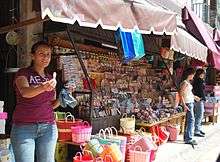
The municipality as a whole is ranked as having a medium level of socioeconomic marginalization.[4] Of the 260 active communities, most are designated as having a medium or high level of marginalization. However, since the vast majority of the municipality's population lives in the city of San Juan de los Lagos proper, which has a low level of marginalization, the ameliorates the situation.[12] As of 2010, there were 15,088 housing units in the municipality.[12] Most housing is privately owned by its occupants, mostly with a poured concrete foundation and with walks of cinderblock, bricks or adobe. Roofs are mostly of poured concrete or vaults made with bricks. Basic services such as running water and electricity are available in about 90% of homes.[4]
Agriculture takes up about half of the municipality's territory, with most farmland privately owned. It employs about 22% of the working population. Principle crops are corn, beans and sorghum, with livestock consisting of meat and dairy cattle, oxen, pigs, sheep, goats and domestic fowl. There is also some fish farming producing catfish, carp and mojarra for local consumption. There is some exploitation of mesquite trees for wood.[4]
Mining and industry employ about 24% of the working population. Mining mostly consists of sandstone production for construction with some deposits of marble and other construction materials. Most industry consists of food processing, much of which is destined for sale to the tourist market.[4] This is particularly true for the production and sale of cajeta or dulce de leche. This is a common traditional product as the Los Altos region is the fifth highest producer of dairy products in the country.[1] Other products include ice, construction materials, ironworking, textiles and furniture.[4]
Handcrafts include embroidered clothing for women as well as the weaving of wool items such as sarapes, rebozos, quezquémetls and other textiles, herbal medicines, leather items such as bags, belts and wallets are made as well as ceramics and carved stone items.[4][2] Clothing for charros can be found here from heavily embroidered jackets and pants to embroidered belts called “piteado.”[2] Another common handcraft is religious items for sale to visitors, such as reliquaries, candles, images of the Virgin and rosaries made from the local white stone.[1] Many of the areas handcrafts are sold on the stores and street stalls around the main plaza and basilica. These items are either made locally or brought in from other states in central Mexico.[2]
Just under fifty percent of the working population is dedicated to commerce and services, with most of this related to tourism to the city of San Juan de los Lagos, followed by businesses catering to local, mostly primary, needs.[4] This translates to a population of about 40,000 residents who cater to the needs of about seven million or so pilgrims per year. The city has frequent bus service, and is accessible by expressway.[6] However, this tourism is almost purely domestic. Most English language guidebooks do not even mention San Juan de los Lagos.[6][1]
The municipality

It has 260 active communities with a total population of 65,684 (2010); however most of these are extremely small and rural with only one community having more than 700 residents, the seat.[12] Outside the city of San Juan, other important communities include Mezquitic de la Magdalena, Halconero de Arriba, La Sauceda, Antenas (Cañada de Pérez), El Sauz de Ibarra and San Antonio de la Barrera.[4] In total, there are 298 named locations in the municipality, but 38 have been abandoned.[12]
In 2005, 111 spoke an indigenous language, up from 24 in 1995, and 95% are Catholic.[4]
The municipality has seventeen preschools, 65 primary schools, seven middle schools two high schools and one vocational/technical school. About 90% of the population is literate; however, the rate was about only half of the population until the 1990s.[4]
Another pilgrimage site is that of the Santo Niño de Mezquitic, also called the Niño Cacahuate, whose feast day is 17 September.[4] This image is located in a small church constructed for it in the community of Mezquitic de la Magdalena, four km outside the city of San Juan. The construction is Neoclassical and dates from the 18th century. The image itself is five centimeters tall contained in a peanut shell, which gives it the name of Niño Cacahuate.[13][14] The veneration of this image began in 1810, but it has grown in the past two decades. Its rise in popularity has made the community another destination for religious tourism in the area.[14]
References
- Ruiz, Sara (February 27, 1999). "San Juan de los Lagos: La Ciudad de los devotos" [San Juan de los Lagos: City of devotees]. Mural (in Spanish). Guadalajara, Mexico. p. 4.
- "San Juan de Los Lagos: Con tradicion y misticismo" [San Juan de los Lagos: With tradition and mysticism]. Reforma (in Spanish). Mexico City. August 10, 1997. p. 4.
- Ricardo Diazmunoz; Maryell Ortiz de Zarate (January 23, 2005). "Encuentros con Mexico / San Juan de los Lagos: Baluarte espiritual" [Encounters with Mexico/San Juan de los Lagos: Spiritual bulwark]. Reforma (in Spanish). Mexico City. p. 17.
- "San Juan de los Lagos". Enciclopedia de los Municipios de México Estado de Jalisco (in Spanish). Mexico: Instituto Nacional para el Federalismo y el Desarrollo Municipal and State of Jalisco. 2005. Retrieved October 14, 2011.
- "Anuncian Festival del Mariachi y Charrería en San Juan de los Lagos" [Announce Festival of Mariachi and Charreria in San Juan de los Lagos]. NOTIMEX (in Spanish). Mexico City. September 10, 2011.
- Ferguson, Richard (January 1, 2009). "San Juan de Los Lagos: The Virgin, her basilica, her pilgrims, and their exvotos". Mexconnect newsletter. ISSN 1028-9089. Retrieved October 14, 2011.
- Gálvez, María Ángeles; Antonio Ibarra (1996). "Comercio Local y Circulación Regional de Importaciones: La Feria de San Juan de los Lagos in la Nueva España" [Local Commerce and Regional Circulation of Imports: The Fair of San Juan de los Lagos in New Spain]. Historia Mexicana (in Spanish). XLVI (3): 581–616. Retrieved October 14, 2011.
- "Mucho más que tamales" [Much more than tamales]. Reforma (in Spanish). Mexico City. January 17, 2010. p. 9.
- "Llegan menos a San Juan de los Lagos" [Fewer come to San Juan de los Lagos]. El Norte (in Spanish). Monterrey, Mexico. February 3, 2007. p. 15.
- Davidson, Linda Kay; David Martin Gitlitz (2002). Pilgrimage: from the Ganges to Graceland : an encyclopedia, Volume 1. p. 571. ISBN 1-57607-004-2.
- "Diocese of San Juan de los Lagos". Roman Catholic Church. Retrieved October 14, 2011.
- "Municipio de San Juan de los Lagos Resumen municipal" [Municipality of San Juan de los Lagos, Municipal Summary] (in Spanish). Mexico: Unidad de Microrregiones Dirección General Adjunta de Planeación Microrregional. 2011. Archived from the original on 2012-04-02. Retrieved October 14, 2011.
- "Capilla del Niño del Cacahuate" [Chapel of the Child of the Peanut] (in Spanish). Mexico: State of Jalisco. Retrieved October 14, 2011.
- José T. Méndez (February 7, 2010). "Veneran imagen de 5 centímetros" [They venerate an image of five centimeters]. Periódico AM (in Spanish). Mexico. Archived from the original on April 6, 2012. Retrieved October 14, 2011.
External links

